Clifford Donald Simak was born on August 3, 1904, in Wisconsin. He died in Minnesota on April 25, 1988. That’s thirty-three years ago as of this Sunday.
While the passage of a third of a century has dimmed his star somewhat, in his time he was well known. My local paper noted Simak’s passing, even though the Waterloo Region Record was not notably interested in matters science fictional nor in events Minnesotan. Among his notable characteristics: a humanism unusual for the science fiction of the time. Others might set human and alien against each other in total war. Simak was just as likely to have them share a porch as they watched a particularly beautiful sunset.
Unfamiliar with Simak? Here are five of his works you could sample.
“The Big Front Yard” (1958)
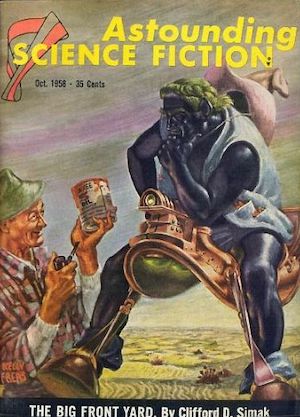
In this quintessential Simak tale, rustic handy man/antique salesman Hiram Taine is startled to learn that his store basement has a new ceiling. It’s a fine ceiling, made from some indestructible material, but Taine didn’t install it. The mysteries don’t stop with the ceiling. A formerly black-and-white television has somehow become colour. Hiram’s front yard somehow opens on a completely unfamiliar vista.
The explanation is straightforward but unexpected: aliens have opened a dimensional gate in front of Hiram’s home. The renovation and the repairs were their initial, inarticulate attempts at first contact. Other men might be horrified by this intrusion of the Other into their lives. Hiram sees people who could be customers and even friends.
Time Is the Simplest Thing (1961)
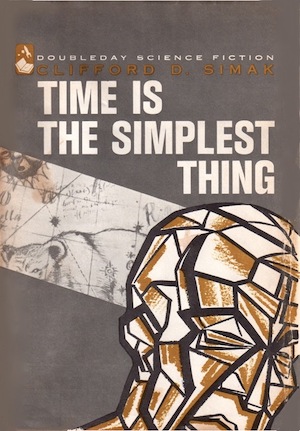
Having learned the hard way that frail human bodies cannot withstand the rigors of interstellar travel, humanity turned to psychic exploration. Where physical exploration fails, psychic exploration succeeds. Casting astral projections to the stars, paranormals—“parries” in the vernacular—like Shepherd Blaine bring home the Milky Way’s wealth…at least, the riches that can be conveyed by a human mind. A bitterly disappointing result for most humans, but a source of great wealth for the Fishhook Corporation, which controls astral exploration.
Shepherd is too successful. After an encounter with a pink blob (who greets him telepathically with the words “Hi pal, I trade with you my mind…”), Shepherd returns home with an uninvited hitchhiker sharing his brain. Now, explorers who bring home guests vanish into Fishhook’s hospitality, never to be seen again. What happens after that is unclear. Certain that he does not want to find out what Fishhook does with (or to) the explorers, Shepherd goes on the run. He discovers that not only did he acquire a passenger out there in the stars, Shepherd himself has been transformed in…interesting…ways.
All Flesh Is Grass (1965)

Millville is an unremarkable small American town, save for the impenetrable, invisible barrier that silently manifests one day. Bradshaw Carter encounters the barrier while driving out of town; he survives the aftermath but his car does not. Carter is left to ask the same questions the other rustics of Millville will ask: Who built the barrier and why?”
The answer is—of course!—aliens. Specifically, purple flowers not of this Earth. The aliens seek harmony and fellowship. Xenophobic, insular humans, not so much. It falls to Bradshaw to search for a bridge between hopeful galactics and suspicious, violent humans. If he fails, he could be crushed in the conflict.
Why Call Them Back From Heaven? (1967)
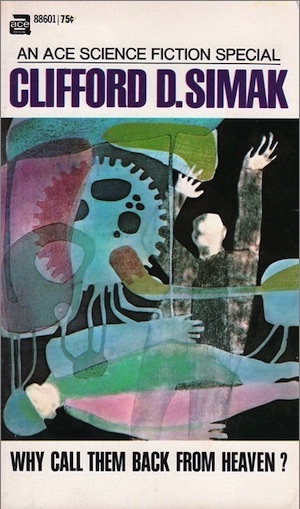
Why waste your life chasing supernatural rebirth in a heavenly paradise (whose existence is a matter of mere faith) when the dead can be frozen and stored in the Forever Center until such time as they can be thawed out and revived to enjoy a very Earthly paradise?
Freezing may cost you everything you own, but surely the reward will be worth it.
By the 22nd century, there are hundred billion corpsicles on ice. Half that number of yet unfrozen humans are slogging away at miserable jobs to pay for their great tomorrow. Who is benefiting now? The Forever Center. This vast, lucrative enterprise will not tolerate even the slightest potential threat. PR man Daniel Frost stumbles across Forever Center secrets and is framed, convicted, and branded as a pariah. Daniel sets out to clear his name, but it would seem that he has little hope of challenging the establishment.
The Goblin Reservation (1968)
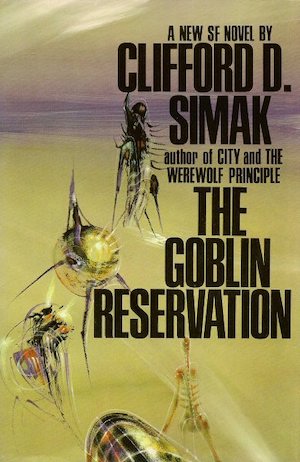
Professor Peter Maxwell returns to Earth from the stars to discover that he is the second Peter Maxwell to return from the stars. His first guess is that he had been intercepted by ghostly aliens in mid-matter transmission; later it becomes clear that the aliens simply duplicated Peter on their crystal planet. Two Professors Maxwell could be very awkward—who gets the faculty parking spot?—so perhaps it is for the best that the original Peter Maxwell died in an apparent accident soon after returning from the alien planet.
The world of tomorrow is an odd one, filled with aliens like the Wheelers, mythical creatures like goblins, trolls, and faeries, and even Neanderthals and English playwrights snagged from the past. Mysteriously duplicated professors seem a picayune strangeness by comparison. In this case, however, Peter was created to deliver an offer from the crystal-world aliens to sell the contents of their vast library. It is an unparalleled opportunity for Earth, a treasure which malevolent entities are determined to have for their own. Unfortunately Peter’s second, final death may follow rather quickly on the heels of the death of the original Prof. Maxwell.
***
What about City and Way Station, you ask? Other Tordotcom reviewers beat me to both.
Perhaps you are new to Simak, in which case I hope you enjoy these. If you are familiar with his fiction, please mention whichever works you feel bear mentioning next to City, Way Station, The Big Front Yard, Time Is the Simplest Thing, All Flesh Is Grass, Why Call Them Back From Heaven?, and The Goblin Reservation. The comments are below.
In the words of Wikipedia editor TexasAndroid, prolific book reviewer and perennial Darwin Award nominee James Davis Nicoll is of “questionable notability.” His work has appeared in Publishers Weekly and Romantic Times as well as on his own websites, James Nicoll Reviews and Young People Read Old SFF(where he is assisted by editor Karen Lofstrom and web person Adrienne L. Travis). He is a four-time finalist for the Best Fan Writer Hugo Award and is surprisingly flammable.










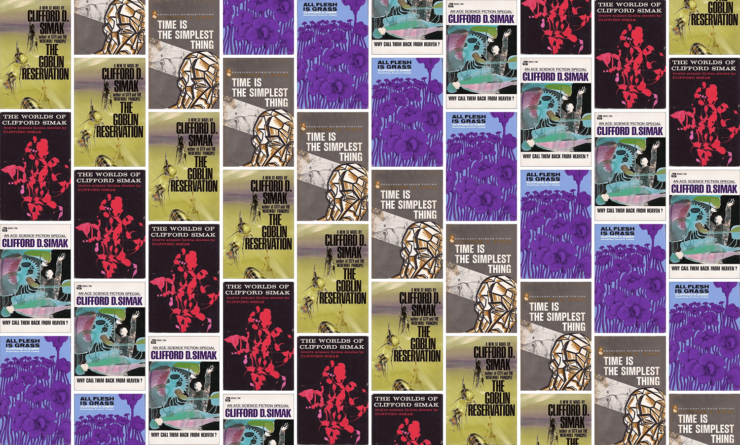
Fans of Simak’s short works will be happy to know that Open Road Media’s The Complete Short Fiction of Clifford D. Simal collects… well, I am sure you can fill in the dots. The series is as follows:
The Complete Short Fiction of Clifford D. Simak
1 I Am Crying All Inside and Other Stories (2015)
2 The Big Front Yard and Other Stories (2015)
3 The Ghost of a Model T and Other Stories (2015)
4 Grotto of the Dancing Deer and Other Stories (2016)
5 No Life of Their Own and Other Stories (2016)
6 New Folks’ Home and Other Stories (2016)
7 A Death in the House and Other Stories (2016)
8 Good Night, Mr. James and Other Stories (2016)
9 Earth for Inspiration and Other Stories (2016)
10 The Shipshape Miracle and Other Stories (2017)
11 Dusty Zebra and Other Stories (2017)
12 The Thing in the Stone and Other Stories (2017)
@@.-@: Hi James–comments with 4+ links are held by the spam filter, and then editing the post sent it back to unpublished. Should be visible now!
Thank you!
As much as I appreciate the Open Road Media series, the collections on which I fixated as a teen were the Ace collections with Michael Whelan covers. For younger people, Michael Whelan is an artist I think could really go places.
Showing the covers for other good Simak saves my having to point them out. SBtV has a good collection of his shorter work, reminding us that authors used to be able to work in all lengths — not just doorstops and series. (“The Big Front Yard” is another demo of this.) And TaA is a great story of how people try to twist a good message.
I’m not sure his work will ever catch on.
The Simak that blew me away in high school was A Choice of Gods. Another posthuman robot book, sort of.
Love love Clifford D. Simak! My town library had a good collection, and I read most of them growing up. Every now and then I still spot one in a used bookstore and I snap it up. My favorite was always Project Pope, although Goblin Reservation is pretty good too!
@10 I was going to post A Choice of Gods too. It sticks out best in my memory. Part of the premise — a large cohort of humanity was dropped on another planet by aliens — seems to have been thoroughly reworked in Catherine Asaro’s Skolian Empire series. It even has psychic powers as another major premise.
Heritage of Stars has also stayed with me a long time, particularly for the bear-killing robot and the phrase “Place of Going To The Stars”.
But apparently the first one I actually read was Cosmic Engineers, which is … less good. It goes all the way back to 1939 so perhaps that’s to be expected.
I bounced off The Werewolf Principle, hard, and never finished it. It’s probably why I stopped picking up his novels.
Goblin Reservation has a special place in my heart. It was the first book I ever read before it was published between two covers. I was getting Galaxy Magazine in 1968 and discovered the wonderful world of serialization. I immediately identified with Oop, the Neanderthal, and the memory of the final dance on the fairy green is firmly embedded in my mind. I still reread it every few years.
My tastes changed in the 70s and Simak and I parted ways. Project Pope, in 1981, brought me back. I still think he is one of the most underappreciated SF writers of all time.
Mastodonia should be up there.
It’s about Asa and his dog Bowser — this is a quote from just a couple of pages in:
—
‘I heard,’ I said. ‘A Folsom point. Ten thousand years ago. Used by paleo-Indians. Found associated
with the bones of prehistoric bison.’
‘Not only that,’ she went on, ‘but mounted on a shaft shaped by scraping—that’s the earmark of pre-historic technology.’
‘Yes, I know,’ I said. ‘I hadn’t meant to tell you right away, but I might as well. Bowser, it seems, is a
time-traveling dog. Once he brought home some dinosaur bones…’
‘Why should a dog want dinosaur bones?’
‘You miss the point. Not old bones. Not fossilized. Not weathered. Green bones, with shreds of flesh still hanging onto them. Not the bones of a big dinosaur. Small one. From an animal the size of a dog or maybe just a little larger.’
—
It gets more interesting from there.
The posthumous anthology Over the River & Through the Woods (Tachyon; 1996) is a fantastic introduction to his fine short work and includes my favorite of his short stories: “The Grotto of the Dancing Deer.” That story won the 1980 Nebula and the 1981 Hugo for short story and still warms my archaeologist heart.
I quite like Time and Again. Asher Sutton has returned in an unflyable spacecraft from a barriered star. He brings enlightenment and deep truth about life. You can say he’s a prophet.
My copy has a really striking Michael Whelan cover.
@12: Asaro need not have been reworking Simak; a large cohort of humanity was dropped on another planet by aliens dates back to at least 1965 (Dare, Philip Jose Farmer).
To my taste, Simak got less wonderful and more gimmicky after Goblin Reservation (which I also love, even though I had to wait for the book to come out after finding the last part in a newsstand copy of Galaxy); I’ve reread the older works and don’t see any sign of the Suck Fairy, so I don’t think I outgrew his leisured pastoral style. (He probably used a contraction somewhere in dialog, but I can’t remember seeing one.) But I’m glad his later works found (and still find) an audience; nobody then or since has written like him.
The lower-left corner of Wisconsin by the Mississippi River is Simak country. I’m not from the midwest, but I’ve been through on a road trip, and it is a lovely landscape with dramatic bluffs and green valleys. It seems like a place very conducive to Simak’s great non-conformist decency and civility.
I recently read Ring Around the Sun, and recommend it. It kept me guessing, and though I had hoped for a different development, it satisfied me. It keeps nearly veering into fable territory, but never quite leaves the potboiler reservation.
I actually own a copy of that issue of Astounding Science Fiction. Picked it up in a flea market for $2.00. Wonder what it goes for these days? A quick check on eBay and it goes for $9.00 to $20.00 USD. Accounting for inflation… I wouldn’t make any money selling it. :)
I clearly remember reading “The Big Front Yard,” from my dad’s Astounding magazine. How could I not, after being drawn in by that wonderful Kelly Freas cover. That earthling is ready to close a deal, and loving every minute of the transaction!
It’s rather different, but H. G. Wells’s short satire “A Vision of Judgment” (1899, collected 1911, says ISFDB) has God collecting all humans living and dead from the planet Earth, scrutinising us, and dropping us on “a planet that whirled about green Sirius” (sic) to try to do better. But the story ends at that point.
I’ve read All Flesh is Grass and really enjoyed it. And yes the basic plot is the same as Stephen King’s under the dome but probably better since Stephen king makes it a horror novel
Simak is one of my favorite SF authors. I agree that the works after A Choice of Gods in 1972 are not as good as his works starting with Time and Again in 1951. Not all are great but so many are – the best have already been named either in the post or in the comments. I am going through my third re-reading of his novels before 1973 and most still hold up. The humanism flowing through them make them work still today – even if the ideas have been used and overused since then. There are no real “ah-hah” moments in Simak’s works (especially these days) but they are filled with “ah – yes” moments. That is why , I think, they still are wonderful stories.
Another great thing about Simak is how lovingly he describes his pastoral settings, simultaneously contrasting them with the advanced tech and making the reader want to live there. Lovely stuff!